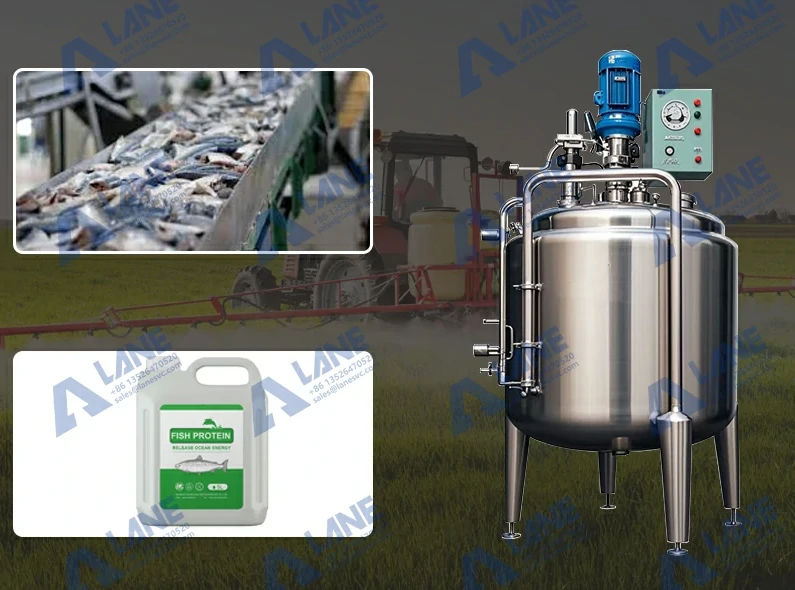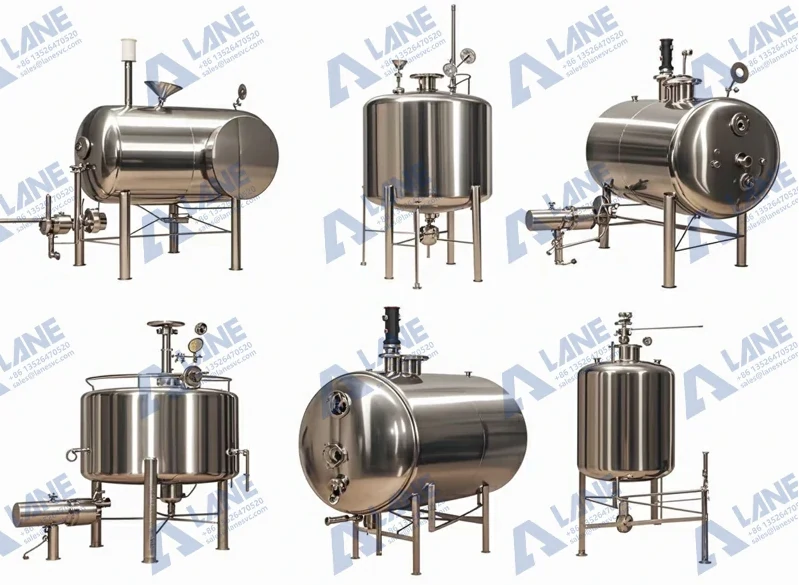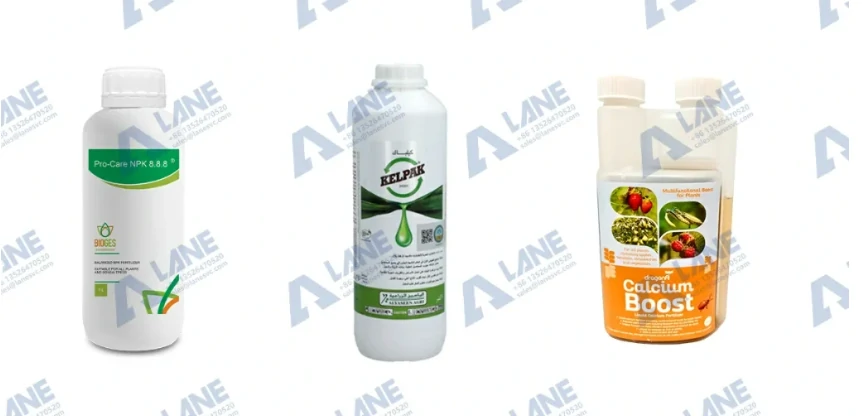
Fish Protein Liquid Fertilizer – Nature’s Powerhouse for Plant Growth
In the rapidly evolving field of sustainable agriculture, fish protein liquid fertilizer has become one of the most reliable and environmentally friendly solutions for farmers to balance productivity and environmental responsibility. It is made from whole fish or fish by-products and provides a comprehensive range of nutrients – rich in nitrogen, phosphorus, potassium, amino acids and essential trace elements. Unlike synthetic fertilizers that are only used for plant growth, fish protein liquid fertilizer can simultaneously nourish plants and the microorganisms in the soil, ensuring the long-term health of the soil and sustainable yields.
Producing fish protein liquid fertilizer involves a carefully designed process to ensure maximum nutrient retention and product quality. Each stage of the production line plays a critical role, and LANE’s advanced equipment ensures efficiency, hygiene, and consistency throughout the operation.
1.Raw Material Processing
The process starts with fresh fish or fish by-products, such as trimmings from seafood processing plants. These materials are first inspected for quality before entering the fish crusher or grinder to break them down into a fine slurry. This increases surface area and improves the efficiency of later processing steps. The ground material is then transferred to storage hoppers or feeding conveyors for continuous, automated supply to the next stage.
2.Fermentation
The prepared slurry is fed into fermentation tanks or enzymatic hydrolysis reactors, where controlled temperature and pH levels allow natural enzymes or beneficial microorganisms to break down proteins into amino acids and peptides. This stage is crucial for creating a nutrient-rich fish protein liquid fertilizer with high bioavailability. Depending on the formula, the fermentation period may range from several hours to a few days, during which mixing paddles or agitators keep the slurry uniform.
3.Filtration & Separation
Once fermentation is complete, the mixture contains both valuable liquid fertilizer and residual solid particles. It passes through a dual filter system or centrifugal extractor to remove solids while retaining all soluble nutrients. This step ensures a clean, stable liquid product that is easy to store, transport, and apply without clogging irrigation or spraying systems.
4.Mixing & Finishing
The filtered liquid moves to stainless steel mixing tanks, where it can be blended with additional organic nutrients, micronutrients, or stabilizers to enhance shelf life. High-shear mixers ensure the formulation is homogeneous and meets precise nutrient specifications. At this point, the fish protein liquid fertilizer is fully formulated and ready for final packaging.
5.Filling & Packing
The finished product is filled into containers using automatic liquid filling machines. LANE offers flexibility in packaging sizes, from small retail bottles (250ml–5L) to bulk containers (20L–1,000L IBC tanks). Each package is sealed, labeled, and prepared for distribution, ensuring farmers receive a product that is fresh, nutrient-rich, and ready to use.

The nutrient spectrum of fish protein liquid fertilizer is what sets it apart. It offers ample nitrogen to encourage leafy green growth, phosphorus for strong root systems and flowering, and potassium to improve plant resilience and crop quality. Amino acids in the fertilizer enhance nutrient absorption and help plants cope with environmental stress such as drought, heat, or transplant shock. The naturally occurring micronutrients—such as calcium, magnesium, and trace elements—support vital metabolic and enzymatic processes, contributing to stronger and healthier crops across different farming systems.
Best Practices for Application
To ensure the best performance of fish-based liquid fertilizer, the correct application method is of utmost importance. The goal is to provide nutrients at the right time and in the right amount, maximize the plant’s absorption rate, and minimize waste to the greatest extent.
For field crops, fertilization is usually most effective during the early growth stage because this is when the nutrient demand is highest. Farmers can use drip irrigation systems or foliar spraying to ensure a uniform distribution of nutrients. In greenhouse production, dilute solutions can be applied more frequently so that plants can absorb nutrients steadily without the risk of excessive fertilization.
For fruit trees or perennial crops, fertilizers can be applied around the root zone through soil drenching or integrated water and fertilizer application. This can act on the active root system, improve nutrient absorption, and stimulate their healthy and vigorous growth. For vegetables and leafy greens, regular foliar spraying can quickly correct nutrient deficiencies and enhance crop quality.
It is also important to adjust the application amount based on the soil test results, crop type and growth stage. Excessive application will waste resources, while insufficient application will limit the yield potential. Farmers should first follow the recommended amount provided by the supplier, and then make minor adjustments based on field observations and actual production conditions.
Finally, to maximize the effectiveness of the fertilizer, please store the product in a cool place and shake or mix it well before use to maintain a uniform consistency. Following the correct procedure ensures that this natural and nutrient-rich fertilizer can be fully utilized each time it is applied.

Farmers and growers have discovered that fish protein liquid fertilizer can perfectly adapt to various crops and cultivation methods.
In vegetable production, it can be used to grow nutritious tomatoes, peppers, and leafy vegetables. In orchards and vineyards, it helps increase fruit set rates and enhance flavor. Grain growers incorporate it into their soil management plans to maintain organic matter levels and achieve stable yields. For specialty crops such as coffee, tea, and herbs, its gentle and effective nutrient release helps achieve high-quality harvests without chemical residue risks.
Even in greenhouse and hydroponic operations, its high solubility and compatibility with controlled environments benefit from these properties, making fish protein liquid fertilizer a common choice in modern agriculture.
Benefits Beyond Plant Nutrition
Although fish protein liquid fertilizer is widely recognized for its rich nutritional content, its advantages go far beyond simply providing nutrients to plants. Its unique organic components and biological activity help improve soil health, build more resilient farming systems, and achieve long-term sustainability in agriculture.
Firstly, the natural amino acids and peptides produced during the fermentation process can serve as soil amendments. They stimulate the growth of beneficial microorganisms in the rhizosphere, improving the soil structure, aeration, and water retention capacity. Over time, this will create a vibrant and balanced soil ecosystem, thereby supporting stronger plant roots.
Furthermore, fish protein liquid fertilizer can enhance the resilience of plants. The bioactive compounds it contains help crops withstand environmental stresses such as drought, salinity, and temperature fluctuations. Farmers who use this fertilizer often report an increase in the uniformity of crop growth and an extension of the shelf life of harvested produce, making it particularly important for both small organic farms and large commercial growers.
Third, it contributes to environmental protection. Unlike synthetic fertilizers, this liquid fertilizer is biodegradable and does not accumulate harmful residues in the soil or waterways. By recycling fish by-products that might otherwise go to waste, it also helps reduce environmental pollution and promotes a circular economy in agriculture.
Finally, for farmers engaged in organic certification programs, this fertilizer provides a compliant, eco-friendly nutrient source. It aligns with organic farming standards in many countries and meets growing consumer demand for chemical-free produce. This not only boosts farm productivity but also strengthens market competitiveness.
A well-known vineyard in Southern France provides a compelling example of how fish protein liquid fertilizer can transform an operation. The vineyard partnered with LANE to set up an on-site production system capable of processing local fish by-products into high-quality liquid fertilizer. Within two growing seasons, the vineyard reported a 20% increase in grape yields and a noticeable improvement in soil texture and organic matter levels. Not only did the vines produce more grapes, but the grapes themselves were richer in flavor, contributing to a premium wine profile that commanded higher market prices. By producing fertilizer locally, the vineyard also cut input costs and reduced its carbon footprint.

LANE has specially developed a comprehensive liquid fish protein fertilizer production line, enabling farms, cooperatives and agricultural enterprises to produce this high-value input product on a large scale. LANE has specially developed a comprehensive liquid fish protein fertilizer production line, enabling farms, cooperatives and agricultural enterprises to produce this high-value input product on a large scale. All equipment is aimed at durability, energy efficiency, and ease of maintenance, and is supported by a global installation team and continuous technical support.
The future of farming is shifting toward practices that balance productivity with ecological responsibility, and fish protein liquid fertilizer is at the forefront of this movement. It delivers consistent crop performance, strengthens soil ecosystems, and offers growers an opportunity to align with the rising demand for organic and sustainable food production.
By investing in advanced production technology—such as the solutions provided by LANE—farmers can secure a reliable supply of premium organic fertilizer, reduce input costs, and open new revenue streams through sales to neighboring farms or export markets. For growers looking to combine profitability with environmental stewardship, fish protein liquid fertilizer is more than just an input—it’s a long-term investment in soil health, crop quality, and agricultural sustainability.
For more details, please feel free to contact us.
Henan Lane Heavy Industry Machinery Technology Co., Ltd.
Email: sales@lanesvc.com
Contact number: +86 13526470520
Whatsapp: +86 13526470520
Leave a Comment
Latest Posts
LANE has more than 500 successful cases and is committed to providing customers with first-class solutions, high-end machinery and equipment, and one-stop pre-sales, sales and after-sales comprehensive customer service.